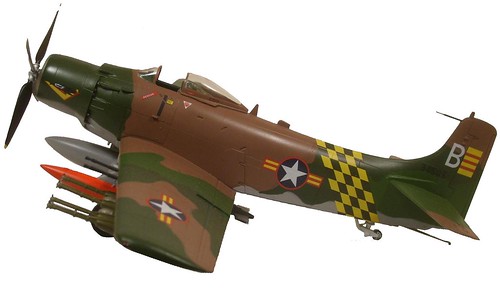AD-6 Skyraider 1/48 MGRM 85-5312 Kit Review
RoR Step-by-Step Review 20121212* – AD-6 Skyraider 1/48 MGRM 85-5312 Kit Review
Click Here to Buy this Kit through Amazon.com
Â
Click the Buy Now link below to purchase the Step-by-Step review by Kevin Lawton 
The Douglas Skyraider was developed toward the end of World War II to fulfill a US Naval requirement for a carrier-based, single-seat, long-range, high performance dive/torpedo bomber, as a follow up to the Curtiss SB2C Helldiver and Grumman TBF Avenger. The first prototype Skyraider (the XBT2D-1) made its maiden flight on March 18th, 1945. The Skyraider was developed too late to see action in World War II, but became the mainstay of U.S. Naval carrier and USMC aviation during the Korean War (1950-1953). Powered by a Wright R-3350-26WA radial engine producing 2,800 hp, the Skyraider could carry up to 8,000 lbs of weapons on 15 hard points for up to 10 hours. Its weapons load and flight time far surpassed and of the newer jet aircraft available at the time.
The Skyraider continued in service during the Vietnam War and U.S. Navy Skyraiders shot down two North Vietnamese Air Force (NVAF) Mikoyan-Gurevich MiG-17 jet fighters: one on 20 June 1965 and one on 9 October 1966. As they were released from Navy service, Skyraiders were introduced into the South Vietnamese Air Force (VNAF). They were also used by the USAF to perform one of the Skyraider’s most famous roles: the “Sandy” helicopter escort on combat rescues. USAF Major Bernard F. Fisher piloted an A-1E on the 10 March 1966 mission for which he was awarded the Medal of Honor for rescuing Major “Jump” Myers.  USAF Colonel William A. Jones, III piloted an A-1H on the 1 September 1968 mission for which he was awarded the Medal of Honor. In that mission, despite damage to his aircraft and suffering serious burns, he returned to his base and reported the position of a downed US airman.
For the modeler: Revell’s model box top represents an AD-6 Skyraider, but the decal & painting guide is for an AD-4E or an A-1H. The model consists of 75 parts, 72 molded in grey plastic and three molded in clear plastic (photo 004). The molds date to 1980 and almost every part shows some flash. This is not an excessive problem but does require a good deal of clean up before opening the glue bottle. The decal sheet includes decals for two aircraft. The first is an AD-4E of the Naval Ordinance Test Station at China Lake California in overall white and International Orange. The second aircraft is an A-1H of the 1st Fighter Squadron of the South Vietnamese Air Force, Squadron Commanders aircraft. The A-1H with its 3-tone camouflage scheme and black and yellow checkerboard fuselage stripe was much more interesting to me and so I chose to build that aircraft. This basic but aged kit makes a great display subject if you have the right information to perfect your build. Adding realism to the guns and exhaust; dealing with excess flash and sinks; cockpit detailing paint selection and highlighting with a silver pencil; glass tints; seam filling; ejection pin locations; cowling modifications for fit; camouflage paint selection and methods; masking techniques; weaponry color selections; prop detailing; canopy detailing with a liquid mask; decal preparation and application; use of Future for sealing; tail wheel height considerations are all fully examined in this 12 page, full-color Step-by-Step review.
Important! – You MUST click on the “Return to Right on Replicas, LLC” link after you’ve made your purchase to download your review!
To see the full build and review – just select one of the payment methods above for $2.99 USD.
 Right On Replicas, LLC ©2012 All rights reserved.
*All registered trademarks are the property of their respective brands.


